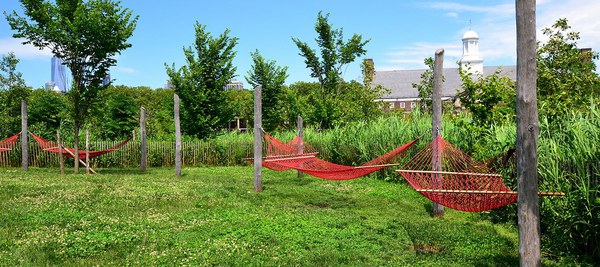Anastasia Day, a PhD candidate in history at the University of Delaware, spent several weeks at Dumbarton Oaks this summer, first as an attendee of the Garden and Landscape Studies summer graduate workshop, and then pursuing her own research as a short-term predoctoral resident. Her dissertation work focuses on victory gardens, makeshift plots used during the Second World War to produce nearly half of America’s fresh produce.
Brief Q&A with Anastasia Day
The seminars are a good mix of “classical” garden studies—learning about French and Italian gardens—and newer approaches, like urbanism. What were some sessions, themes, or ideas that particularly stood out to you?
First I want to say that the seminar itself is a huge gift to a variety of scholars for the simple reason that the field of garden and landscape studies is very ill-defined. It incorporates insights not only from landscape architecture but also from art history, history, environmental history, sociology, architecture, American studies, even literature, like Leo Marx’s The Machine in the Garden. So just having a seminar where people who are interested in all these similar ideas can sit down and work to read across a shared canon of books, so that we can more fully engage with each other, was incredible.
I found some of the most eye-opening seminar sessions to be when we were putting theory more directly into practice. The field trips to Richmond and Charlottesville were breathtaking, in part because of the timeliness of the subject. We’re nearing the one-year anniversary of the Charlottesville protests last summer, so to be reading these fantastic articles about the slave plantation as panopticon, and Daniel Bluestone writing about the revival of Tobacco Row in Richmond in ways that totally erased the slave labor that went into the tobacco industry, and then to visit these sites with Bluestone and other experts and to see that erasure and palpably feel the silences around these confederate monuments was incredibly powerful. At least in my time in grad school as a historian, it’s been rare to get the chance to pair reading and experience in that way. That was breathtakingly important—not just intellectually, but in a moral and social way as well.
What was your tour of the National Mall like?
That was a wonderful morning spent with Director of Garden and Landscape Studies John Beardsley, who ushered us around. I have to say, I think several of us experienced it as an anthropological foray—looking at the human landscape of tourists exploring these monuments as much as at the monuments themselves.
John directed us toward thinking about the mall as a landscape of commemoration, and considering what gets memorialized, and for what reasons. We spent a lot of time on the contrast between the Vietnam Veterans Memorial and the Korean War Veterans Memorial, asking: Is this about the lives lost, or is this about the act of war? Or is this about the outcome, or the process? Is this an elegy, or a commemoration? Or is it all these things, and to what degree is it each? Which groups want to see what stories or messages in these different landscapes? How, in coming up with these designs, have landscape architects vied against input from veterans’ groups and the desires of the public to see certain messages in these monuments? It really helped open my eyes to a landscape I’ve been visiting on field trips since the fifth grade in a new, critical way.
How did the workshop affect how you think about your own academic work?
It helped me refine my thinking in a number of ways. One benefit was that it gave me some metaphorical breathing space. As a historian, I’ve spent a lot of time posturing and aggressively defending gardens as a “serious topic” worthy of investigation, something we can do “important history” with, so being at Dumbarton Oaks, where everyone else shared that premise, gave me room to exhale. It was an opportunity to grapple meaningfully with the work I’m doing with gardens, how I’ve been approaching them, and how I was interacting with other garden scholarship, instead of just addressing more mainstream historical conversations. The impact on my scholarship is going to be colossal, and for the better, without a doubt.
I found myself in a curious situation when I came into the workshop, because I’d vaguely assumed that it would be mostly fellow historians attending, with a couple of other disciplines scattered in, and instead I was the only historian this year. That was profoundly refreshing and revitalizing for me, and I think helped me examine the scholarly tools I’m using, what questions I’m asking, what questions I’m not asking. It really helped me refine my thoughts and approaches.

